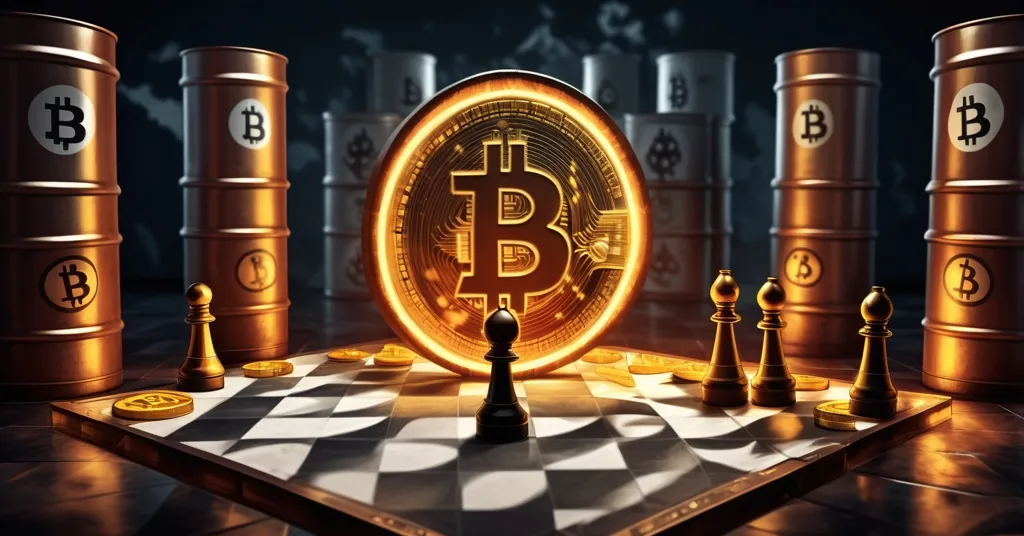Iran’s Uranium Rollback Proposal: Sanctions, Conflict, and Bitcoin’s Evasion Role

Iran’s Nuclear Proposal: Uranium Rollback, Sanctions Threat, and Bitcoin’s Role in Evasion
Iran has ignited global headlines with a tactical offer to slash its uranium enrichment from a near-weapons-grade 60% to 20%, a move aimed at dodging UN snapback sanctions from Britain and the EU while sidestepping military confrontation with Israel and the US. Yet, beneath the diplomatic veneer lies a tangled mess of internal rifts, geopolitical saber-rattling, and a shadowy wildcard: Bitcoin and cryptocurrency as tools for sanctions evasion.
- Iran offers to cut uranium enrichment to 20% to avert sanctions and conflict.
- Internal divisions pit reformists against hardliners, complicating the proposal.
- Bitcoin emerges as a potential lifeline for Iran to bypass economic restrictions.
Nuclear Rollback: A Calculated Retreat
Iran’s nuclear ambitions have been a persistent thorn in the side of international relations for decades. The latest maneuver comes from Ali Larijani, reappointed as security chief under President Masoud Pezeshkian, who’s pushing to dial back uranium enrichment levels. For the uninitiated, uranium enrichment is the process of boosting the concentration of uranium-235, an isotope essential for nuclear energy—or weapons, if pushed to 90%. At 60%, Iran is dangerously near that red line, which is why global powers are on edge. Under the 2015 Joint Comprehensive Plan of Action (JCPOA), often called the Iran nuclear deal, enrichment was capped at 3.67% in return for sanctions relief. That agreement crumbled when the US pulled out in 2018, prompting Iran to ramp up its program in defiance. Learn more about the history of Iran’s nuclear program.
Larijani’s proposal to reduce to 20%—still breaching the JCPOA limit—is a bid to cool tensions with Britain, France, and Germany. These nations can trigger snapback sanctions, a sort of emergency switch to reinstate pre-2015 penalties without full UN consensus, until October 18, 2025. After that deadline, any sanctions move needs UN Security Council approval, where Iran’s allies like Russia and China could slap down a veto. The urgency is palpable: Iran’s economy is in freefall under existing sanctions, with runaway inflation and scarce essentials. Military threats loom large too, with Israel—viewing Iran’s nuclear program as a mortal danger—having struck Iranian targets as recently as June, and the US maintaining relentless economic pressure. A senior official close to the talks laid out Larijani’s motivations plainly:
“Larijani is trying to convince the system to reduce the level of enrichment to avoid another war.”
The official doubled down on the stakes:
“He’s concerned that without lowering it or meeting some of the West’s demands, the system will face another major challenge.”
Even at 20%, though, don’t expect Western powers to throw a parade. Iran’s refusal of conditions like International Atomic Energy Agency (IAEA) inspections or direct talks with the US, coupled with Europe’s floated six-month snapback extension if negotiations resume, suggests this compromise might be dead on arrival. For deeper insight into Iran’s offer to reduce enrichment levels, the context is critical.
Internal Fractures: A Nation at Odds
Inside Iran, this proposal isn’t a unified strategy—it’s a full-blown showdown. Reformists, backing Pezeshkian’s administration, see dialogue with the West as a path to lift crippling US sanctions, arguing for concessions like halting enrichment. Hardliners, led by the iron-fisted Islamic Revolutionary Guard Corps (IRGC), call this surrender, a betrayal of national pride and security. Aziz Ghazanfari, the IRGC’s deputy political chief, didn’t hold back on the Bassirat website, slamming any hint of weakness:
“Foreign policy is not a place to state every reality… the dangers of careless remarks by senior officials fall first on their own governments.”
Adding to the chaos is the conspicuous silence of Supreme Leader Ayatollah Ali Khamenei, who’s barely appeared publicly since Israel’s June strikes. Without his decisive voice, it’s anyone’s guess whether Larijani’s pragmatic approach will gain traction or get steamrolled by the IRGC’s defiance. This rift could even spill into other arenas—like cryptocurrency. Reformists might view Bitcoin as a practical workaround for sanctions, while hardliners could see its borderless, uncontrollable nature as a threat to state authority. The IRGC’s resistance to Larijani’s stance highlights these internal tensions.
Geopolitical Powder Keg: Markets on Edge
The ripple effects of this standoff are massive. Iran has warned it could close the Strait of Hormuz—a narrow waterway handling 20% of global oil shipments—to US and European vessels if snapback sanctions hit. Such a blockade would likely send oil prices into the stratosphere, echoing the chaos of the 1979 Iran Revolution, and could disrupt economies worldwide. Larijani has described the conflict with Israel as “paused” but not resolved, while Iran’s defense ministry flexes muscle with fresh ballistic missile drills and upgrades to radar and air defense systems. Meanwhile, the 2025 snapback deadline looms, with Europe dangling a six-month extension if Iran plays ball—a condition Tehran has so far scoffed at. The implications of the snapback clause expiring in 2025 are a critical factor in this geopolitical chess game.
For those of us tracking markets, this tension could jolt more than just oil. Geopolitical flare-ups often drive volatility, and some investors might turn to Bitcoin as a hedge against fiat uncertainty. But let’s not drink the Kool-Aid—Bitcoin’s track record in crises is spotty. It’s spiked during some global unrest but cratered in others when risk-off sentiment grips markets. If the Strait of Hormuz becomes a flashpoint, expect wild swings, not a guaranteed safe haven.
Bitcoin’s Shadow Play: Sanctions Evasion in Focus
Now, let’s zero in on what makes this saga hit home for our community: Iran’s flirtation with cryptocurrency as a sanctions-busting tool. Cut off from traditional banking by Western penalties, Iran has turned to Bitcoin mining to generate funds for international trade. Since at least 2021, state-sanctioned mining farms—often fueled by dirt-cheap, subsidized electricity—have churned out crypto, with estimates suggesting millions in Bitcoin have flowed through these operations, though hard numbers are slippery given blockchain’s pseudonymous nature. Iran briefly legalized mining under strict controls, only to crack down during energy crunches, exposing the practical headaches of this approach. The impact of sanctions on Iran’s Bitcoin mining sheds light on these challenges.
Looking ahead, decentralized finance (DeFi)—financial systems built on blockchain that sidestep traditional banks—could offer Iran even broader channels to move money globally. This fits squarely with the ethos of decentralization we champion, a defiant stand against centralized powers like the UN or EU enforcing sanctions. Larijani’s own distrust of the snapback mechanism’s legitimacy, especially after the US ditched the JCPOA, almost echoes a crypto-anarchist gripe against overbearing fiat systems. From the lens of effective accelerationism (e/acc), Iran’s pivot to blockchain, even if messy, speeds up the tech’s global footprint—a backhanded win for disruption. Curious about how Iran uses Bitcoin to evade sanctions? The strategies are complex and evolving.
But let’s keep it real. If Iran doubles down on crypto for illicit ends, it could poison Bitcoin’s narrative. Regulators, like the Financial Action Task Force (FATF), are already hawkish on crypto for money laundering and sanctions evasion. A high-profile scandal tied to Iran’s nuclear antics or proxy wars could spark harsher crackdowns, scaring off institutional players and stunting mainstream adoption. And while we’re all for shaking up the status quo, Iran’s military posturing and nuclear games aren’t the freedom fight Bitcoin was meant to back. We’re walking a tightrope between empowering the oppressed and enabling chaos—don’t pretend otherwise. For more on Iran’s cryptocurrency evasion tactics, the data is eye-opening, and community perspectives on platforms like Reddit discussions about Iran and Bitcoin add further depth.
Q&A: Iran, Sanctions, and Bitcoin’s Dual Nature
- Why is Iran pushing to lower uranium enrichment levels?
Iran seeks to avoid UN snapback sanctions from the EU and UK, deter military strikes by Israel or the US, and alleviate pressure on its battered economy. - How does Bitcoin play into Iran’s strategy against sanctions?
Iran has leveraged Bitcoin mining to generate funds for trade outside conventional banking, with potential to expand into DeFi for wider financial maneuverability. - What risks does Iran’s crypto use pose to the broader market?
Geopolitical fallout, like a Strait of Hormuz closure, could fuel market volatility, while illicit use narratives might trigger regulatory backlash, tarnishing Bitcoin’s image. - Why does the 2025 snapback deadline matter so much?
After 2025, Western powers lose the ability to unilaterally impose sanctions, and allies like Russia or China could block UN measures, handing Iran a stronger position. - Should the crypto community back Iran’s blockchain pivot?
It’s a thorny issue—decentralization can empower those under oppressive systems, but supporting controversial regimes risks ethical conflicts and regulatory heat, a tension worth debating.
Final Reflections: Decentralization in the Crosshairs
Iran’s nuclear chess match, blending uranium rollback offers, sanctions dread, and crypto undercurrents, lays bare the messy clash between centralized control and decentralized defiance. For those of us rooting for Bitcoin and blockchain, it’s a gut check on our tech’s double-edged potential—a beacon of autonomy for the downtrodden, yet a lightning rod when caught in state-level power plays. Whether Larijani’s call for honest negotiation over diplomatic theater gains ground or collapses under internal and external strain, the overlap of geopolitics and decentralized systems demands our attention. If the Strait of Hormuz turns into a battleground, Bitcoin’s price might reflect the chaos—either as a refuge or a victim. Let’s stay sharp, champion freedom’s tools, and never shy from dissecting the good, the bad, and the downright ugly of this space. For a detailed look at the 2023 uranium enrichment reduction proposal, the nuances of these negotiations are worth exploring.



